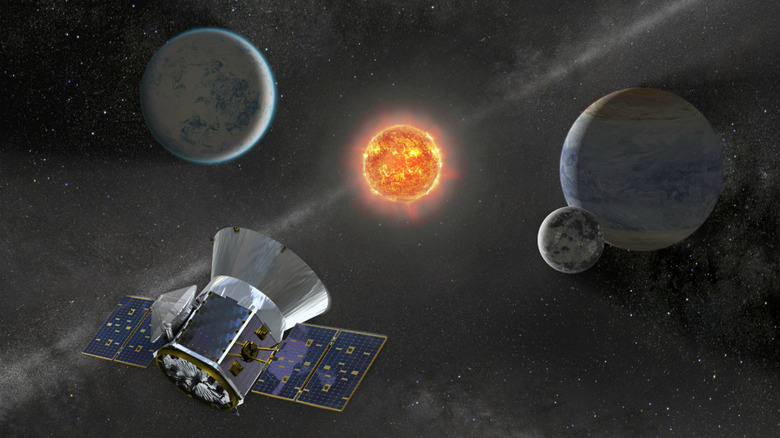This NASA Telescope Has Discovered 329 New Exoplanets In Just Five Years
One of the biggest areas of research in astronomy right now is the discovery of exoplanets, or planets outside our solar system. With over 5,000 exoplanets known and more being discovered every month, you might think that this field is well-established — but in fact, it's rather recent, with the study of exoplanets only really taking off in the last decade or so. A big part of the explosion of exoplanet studies has been new tools that allow scientists to discover these far-off worlds more readily than ever before.
The new generation of exoplanet-hunting tools arguably began with the launch of the (now retired) Kepler Space Telescope in 2009, which ceased operations in 2018. But the baton was picked up by subsequent instruments, like NASA's Transiting Exoplanet Survey Satellite, also known as TESS. Launched in 2018, NASA recently released some figures for TESS's achievements from its first five years in space. In this time, TESS has discovered an impressive 329 new exoplanets, as well as discovering thousands more candidate exoplanets.
These candidates are from early data that suggests a planet could be present, but where more data is needed to verify that one definitely exists. To detect these worlds, TESS monitors the sky and collects images with a total of 192 million pixels each. With one of these images collected every 30 minutes or less, that's a lot of data. "The volume of high-quality TESS data now available is quite impressive," said TESS project scientist Knicole Colón. "We have more than 251 terabytes just for one of the main data products, called full-frame images. That's the equivalent of streaming 167,000 movies in full HD."
How TESS detects exoplanets
It isn't easy to find planets orbiting distant stars. Because planets are so small and dim compared to the stars they orbit, it's rare for telescopes to be able to observe the planets directly. Instead, astronomers use telescopes to observe the stars around which the planets orbit, called host stars. By observing changes to the host star, they can learn about whether a planet or planets exist there.
TESS uses an exoplanet detection method called the transit method. This is where you look at the brightness of a given star over time. If there is a planet orbiting that star when it passes between us and the star (called a transit), the star's brightness will dip very slightly. If you observe that dip in brightness at regular intervals, you can work out whether there is a planet there and how quickly it orbits that star. The amount by which the brightness dips can also help give information on things like the planet's size or orbit too.
To see these dips in brightness, though, you need to observe the star in question at several different points. First, you need to see the star at its usual brightness, then during the transit, then after the transit. And scientists like to observe these transits multiple times so they can be sure that what they are seeing is definitely due to the presence of a planet and not another factor. That's why TESS gathers so much data — because it needs to observe lots of stars and see them at multiple points in time to know whether they have planets orbiting them.
From light curves to exoplanets
The way that researchers get data from the telescope to see these changes in a star's brightness is by using a form called a light curve. These figures plot the dips in the star's brightness over time, showing when a planet could be passing in front of the star. The data is taken from the big view of large portions of the sky which TESS takes images of each night.
"TESS extracts parts of each full-frame image to make cutouts around specific cosmic objects – more than 467,000 of them at the moment – and together they create a detailed record of changing brightness for each one," explained Christina Hedges, lead for the TESS General Investigator Office. "We use these files to produce light curves, a product that graphically shows how a source's brightness alters over time."
It is this system and this huge bank of data that have allowed TESS to identify so many exoplanets. But there are other reasons that a star might brighten, such as if it is going supernova, so TESS has observed hundreds of supernovae in its time as well. Some of the exoplanets discovered by TESS have been in the habitable zone, which is the region around a star in which liquid water could exist on a planet's surface, so it could be that a world on which we might discover life has already been spotted by TESS. TESS has already completed its two-year primary mission and is now on its extended mission, but it continues to operate well so we can expect it to continue discovering many more exoplanets in the years to come.
